Comments from the Chair
Texas Legislature is, thankfully, over
I write on Sine Die, the merciful end of another Texas Legislature. It is too early to have a full damage report from our Chapter Interim Director & Conservation Director Cyrus Reed, Ph.D. Please check the Lone Star Chapter website for updates.
Several SA members went to Austin (some more than once, especially our Tree Ordinance Defender Richard Alles) to lobby for a few good bills, and against many bad bills. Bad bills that passed include a bill that will severely criminalize peaceful protest efforts against things like pipelines and abuse of eminent domain.
There was also a SAWS dream bill to allow them (“our” water utility) to export Edwards Aquifer water away from us. Say what??...but yes indeed. SAWS was also able to push through language aligning its pumping and transportation permits for Vista Ridge water, again undermining local Groundwater Conservation District authority.
Legislation passed to develop a statewide flood management plan, similar in concept to the conservation districts managing water supply. This could actually be good if activists stay engaged and stop the anticipated rush for cement projects everywhere.
The Texas Emissions Reduction Program (TERP) was extended which was an important win. Unfortunately a program to help low income families get rid of clunker polluting vehicles was left with zero funds. Our tree and aquifer protection ordinances were attacked again...of course! Our paid sick leave ordinance was attacked but I think survived.
An Oil & Gas (O&G) bill pushed an end run around EPA’s ongoing study of consequences of dumping O&G water waste (much of it contaminated with a toxic brew of “proprietary” chemicals) on to our landscape, into our creeks and aquifers. The bill will force TCEQ to set up rules permitting this.
Our radioactive nuclear waste purveyors “Waste Control Specialists” (WCS) appear, after what looked to be defeat, to have succeeded in resurrecting gift language to themselves. They don’t like having to pay fees to the State regulators to support the cost of monitoring their extremely toxic waste dump in Andrews County, and they don’t like chipping in to a clean up fund toward the eventual costs of “permanent” disposal of this mess. I have followed WCS for decades. Virtually every legislative session brings them to Austin with more hand out requests, corporate welfare of the worst sort in my opinion. It appears they sneaked their gifts through in the last moments, hidden in innocuous sounding packaging. We can all thank Rep. Cesar Nevarez (D-Eagle Pass) for this dirty trick. I guess the tiny Texas border community of Sierra Blanca, which fought and defeated WCS first efforts to dump on that group of poor people of color, is not in Rep Nevarez’ District, or he doesn’t know his history, or he just doesn’t care...More on all this later.
Climate plan needs a push to get it over the finish line
We must hope we get a Mayor and City Council that can pass a Climate Action & Adaptation Plan (CAAP) this fall, and we must redouble our efforts to overcome blind, selfish, short sighted opposition. The cost of business as usual will be far greater than the cost of the CAAP!!! Let’s act now to improve the future for our children!
In the two years that this community has worked on a climate plan grounded in science, practicality and equity, the science confirming the crisis we face continued to mount. Our climate is changing more rapidly than anticipated, while the predicted dangers are already happening, extending the science.
Meanwhile the sixth extinction is happening, with over one million species disappearing. The “silver” lining in the bad news is that renewable clean energy is better and cheaper than ever, and technology such as electric vehicles improves rapidly. Our main deficiency is lack of political will.
At long last, CPS Energy improves transparency
The May Board of Trustees (BoT) Meeting finally produced important and substantial changes in CPS Energy governance, thanks to Mayor Ron Nirenberg! There was considerable debate and push back against our efforts to improve transparency with CPS. However, the Mayor carried two important motions to this end, and both passed thanks to his strong support and defense of these efforts by local activists.
He argued successfully that, whatever might have been normal and acceptable in the past, is no longer, with citizens demanding (politely) more accessibility, transparency and accountability from their utilities. As a result, the BoT tasked CPS management to develop video live streaming and archiving of BoT meetings, and allowance for Citizens to be Heard procedures at their BoT. I believe that changes are also underway in the, heretofore secret, “CPS Citizens Advisory Committee" which will also provide greater transparency. I thank Mario Bravo of EDF and current Environmental Stakeholder Committee Chair for his two year persistent leadership in helping us achieve these goals.
Transportation plans key to tackling air pollution, climate change
ConnectSA is the joint City of San Antonio/Bexar County/VIA effort started a year ago to address our transportation needs, building on and coordinating the following:
- the transportation portion of the SA Comprehensive Plan, and
- VIA’s Vision 2040, and
- AAMPO long term Metropolitan Transportation Plan (MTP), and
- five year interim Mobility 2030, 2035, 2040 and 2045, and
- TxDoT Capitol-Alamo Connections Study.
Public outreach will start soon and hopefully be complete by late fall 2019. Interested parties are urged to let me know, and get involved so we can have lots of volunteers taking the “Meeting in a Box” presentations to many different groups and venues around our area to discuss our needs, our options, and get public input on best choices to move forward. We will also be doing similar “Meeting in a Box” presentations to the community about CAAP.
Transportation is of course a large component of our fossil fuel emissions, and of our air quality non-attainment for ozone. We have only about 18 months to get our air better if we are to avoid going from “marginal” to much more draconian “moderate” non-attainment status.
Lions Field events have ended
Some may have noticed the disappearance of Lions Field events on our monthly calendar. We have had considerable trouble filling this part of our calendar, and trouble with turn out at these events (although the last event, Kevin Hartley’s discussion of Bears Ears Monument in May, was very well attended). Organizationally our leadership is stretched, and the Executive Committee voted to cancel future meetings at Lions Field. We would like to develop a more informal, social gathering opportunity, possibly rotating through various sites around the San Antonio area. Ideas and volunteers are welcome!
by Terry Burns, M.D., Alamo Group Chair
Retrofitting Ecology into the Urban Environment
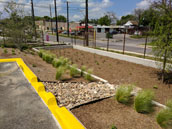
Historically, the urban environment has been built without consideration for healthy ecosystems. Over time, we’ve learned more about our dependence on functioning ecosystems and have realized that eliminating ecological functions on development sites is detrimental for both humans and the environment.
At our June general meeting, Lee Marlowe and Nefi Garza, PE will describe how new practices are being implemented that turn traditional approaches upside down by utilizing stormwater and native vegetation as valuable resources, instead of viewing them as problems.
Tuesday, June 18th
6:30 p.m. {refreshments served beginning at 6}
William R. Sinkin Eco Centro, 1802 North Main Avenue
Map
Current approaches, including Green Infrastructure (GI) and Low Impact Development (LID), demonstrate that ecosystem services can successfully be integrated into urban areas, benefiting people and nature. This presentation will highlight projects within urban areas along the San Antonio River that utilize GI and LID design principals to convert degraded sites including barren traditional commercial landscapes, concrete ditches and channelized drainage ways from lifeless landscape elements into attractive spaces where people like to spend time and nature is allowed to thrive.
Lee Marlowe is a Sustainable Landscape Ecologist with the San Antonio River Authority. Nefi Garza is the Assistant Director of the the City of San Antonio's TCI-Stormwater Department.
This event is free and open to the public.
Three Anti-environment Bills Fail to Pass
Three bills that would have harmed San Antonio's environment failed to win approval in the 86th Texas Legislature.
Campbell bill could have undermined tree ordinance
Although nobody testified in favor of Senate Bill 422, it was passed by the Senate and a House committee, but never made it to the House floor in time for a vote. In the last week of the session, Senator Campbell added SB 422, as an amendment, to another bill (HB 3750) which was intended to nullify certain Austin water quality protections.
HB 3750 was then sent back to the House with Campbell's amendment. When it came to the floor, a point-of-order, raised by Representative Erin Zwiener, killed the bill.
SB 422, as initially drafted, would have undermined 27,000 acres of San Antonio's tree preservation ordinance and given a huge taxpayer-funded windfall to developers.
Another Campbell bill would have led to massive clearcutting
After a contentious hearing, Senate Bill 2078 was left pending in a Senate committee. It would have nullified 410,000 acres of San Antonio's tree preservation ordinance and 46,000 acres of its aquifer protection ordinance.

Bill would have allowed destruction of endangered species habitat
House Bill 969 passed out of a House committee after a hearing where nobody testified in support. The cities of San Antonio and Austin cut a deal with the author to drop opposition in exchange for retaining regulatory authority on commercial developments.
However, it was never referred to the House floor for a vote. It would have decimated endangered Golden-cheeked warbler habitat by allowing homebuilders to destroy old-growth Ashe juniper trees.
by Richard Alles, Forests/Trees conservation leader
Death Valley Views: Telescope Peak
In October, 2018, I drove around the Sierra Nevada Range car camping and doing a bunch of day hikes in Yosemite, Kings Canyon, Sequoia, and Death Valley national parks. I had never climbed Telescope Peak, the highest in Death Valley at 11,049', and it was the perfect time of year to do this so I had no excuses. It is a challenging hike due to the distance and elevation gain, but the trail is mostly easy.
This hike is 12.6 miles and with a 3000' elevation gain from Mahogany Flats campground, which is right across from the trailhead. The road is recommended for high clearance vehicle only, but beyond Thorndike Campground you need 4WD. So I camped at Thorndike, which made it a 14.2 mile hike with a gain of 3700'. Here is an NPS description of the route with excellent photos.
An unexpected challenge was extremely high gusty winds. I stopped to put on my jacket on the long ridge, in the last picture below, and could easily have lost it if I hadn't been very careful.
The views (see picture below) from the summit are pretty neat as you can see Badwater, the lowest elevation in North America at -282', mountains to the east in Nevada, and also Mount Whitney, the highest peak in the lower 48 states, to the west. An article featuring other views in Death Valley was published in the February, 2017 Alamo Sierran.
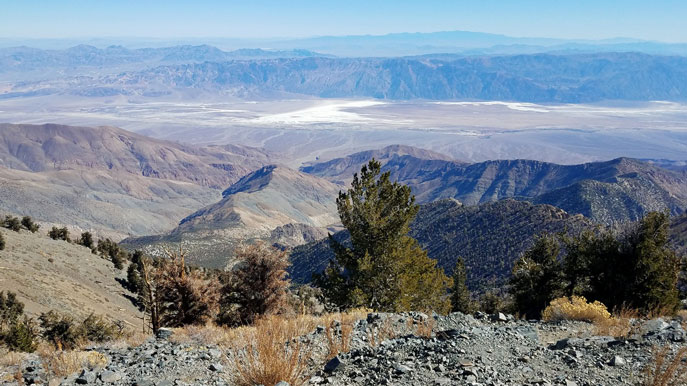
There are bristlecone pines high on the mountain. Some of these trees, found in other parks, are the oldest known living organisms. There was an article about them in the December, 2017 Alamo Sierran.
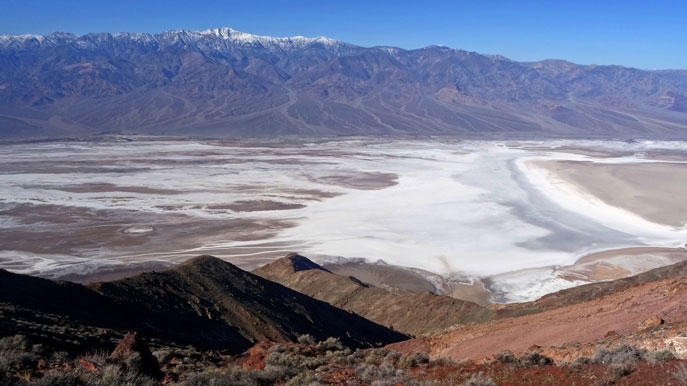
One might wonder how Death Valley came to be the lowest elevation on the continent. Or why Badwater is so low given that its region, on the northern edge of the Mojave Desert, is at generally higher elevations than in the Sonoran Desert to the south. A Wikipedia article explains that the valley is a graben, a downdropped block between mountain ranges. During the Pliestocene Era a lake, 100 miles long and 600' deep, was there.
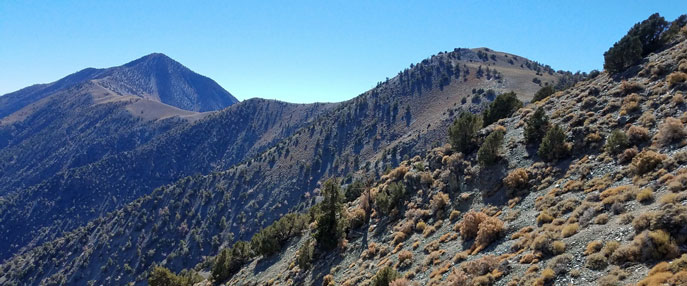
Man's attitude toward nature is today critically important simply because we have now acquired a fateful power to alter and destroy nature – but man is a part of nature, and this war against nature is inevitably a war against himself.
Rachel Carson, quoted in The Hour of The Land - A Personal Topography Of America's National Parks by Terry Tempest Williams
Requiem for a Great Environmentalist
Longtime Alamo Group member Olivia Eisenhauer died of leukemia on Earth Day, April 22nd, two days short of her 89th birthday. Olivia was a member of the Alamo Group's political committee and helped at tabling events, among other activities. On numerous occasions, she spoke eloquently before City Council and the Texas Legislature on behalf of the environment .
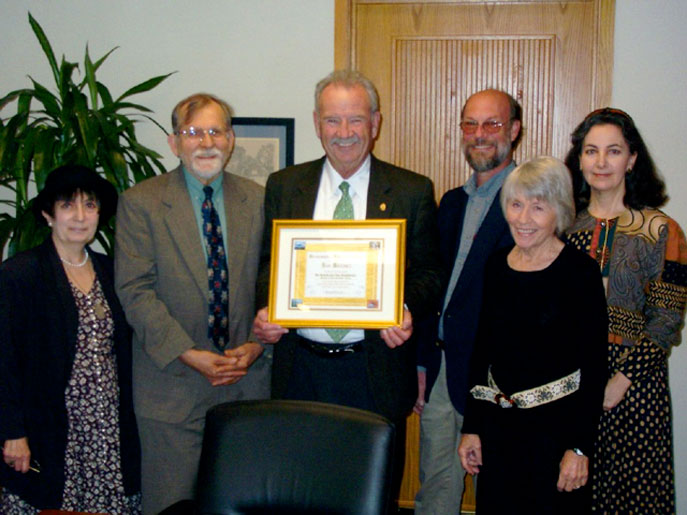
Olivia held out against developers who wanted to buy her ranch in Converse and sought instead to have it become a nature area. Her children hope to keep the ranch going as long as possible.
Services for Olivia were held outdoors at her ranch. A representative of the Alamo Group was in attendance.
by Loretta Van Coppenolle, Energy conservation leader
Climate Asteroid Fast Approaching
Editor's note: This op-ed was published in the May 28th edition of the San Antonio Express-News
At least three op-eds have appeared recently in the Express-News that say a “prudent” approach to climate change will work just fine.
County Judge Nelson Wolff and CPS Energy President and CEO Paula Gold-Williams praised CPS Energy’s FlexPath (“CPS Energy approaching change prudently,” Another View, May 13, and “Difficult energy talks will pay off,” Another View, April 8). Bernard Weinstein touted “clean-burning” natural gas (“Natural gas making U.S. a green leader,” Another View, May 20).
In addition, Wolff and Gold-Williams both argued that the city’s proposed Climate Action and Adaptation Plan, or CAAP, will cost too much, hurting the city’s businesses and poorest residents the most. None of these addressed the real urgency of climate change. Rather, they sounded as if San Antonio and the world had the problem of climate change well in hand. Nothing could be further from the truth.
Please, imagine scientists have told us an asteroid will hit the Earth in 2030 — that it will wreck our economies, destroy our coastal cities, and ravage humanity with drought, floods and disease. What price would we say is “too high” to divert or destroy that asteroid?
Well, the asteroid of climate change has been identified by scientists, and they now say we have until roughly 2030 to take massive efforts to divert it. Otherwise, it’s going to hit us hard.
The figures in the recent report from the United Nations Intergovernmental Panel on Climate Change tell us this: We need to cut our CO2 emissions 45 percent by 2030. If you’ll look at the figures in the draft CAAP, 48 percent of San Antonio’s emissions come from coal- and gas-fired power plants. Natural gas still emits tons of CO2. Without doing anything else, San Antonio could meet that 45 percent goal. If you throw in electric vehicles and mass transportation (another 38 percent of the city’s greenhouse gas emissions come from vehicles), we can mostly likely meet our city’s commitment to meet the Paris agreement.
Some say quick transition to solar and wind power would cost too much. What is the expense of not transitioning quickly? Our own government’s Fourth National Climate Assessment states that U.S. weather disasters in the past four years come at a total cost of nearly $400 billion. In an understatement, the report says, “Acting sooner rather than later generally results in lower costs overall for both adaptation and mitigation efforts.”
California has committed to generating 60 percent of its energy from renewable sources by 2030 and 100 percent by 2045. CPS is committed to the CAAP but still has plans to burn gas and coal beyond 2040, mainly because of cost.
Surely in Texas and San Antonio, bastions of free-enterprise and innovation, we can match California in vision and ambition. We need to include in the CAAP a plan to close our coal and gas plants by 2030 and a plan to transition away from gas-powered vehicles soon thereafter.
Burning fossil fuels until 2040 is tantamount to doing nothing, and the cost of doing nothing will be astronomical. The asteroid of climate change is approaching — fast. How much are we willing to pay to save a habitable Earth?
Wendell Fuqua of San Antonio is a member of the local Sierra Club's Executive Committee.

Outings: The Call of the Wild
Visit the Alamo Sierra Club Outings page on Meetup for detailed information about all of our upcoming Sierra Club Outings.
The Alamo Sierran Newsletter
Richard Alles, Editor
Published by The Alamo Group of the Sierra Club, P.O. Box 6443, San Antonio, TX 78209, AlamoSierraClub.org.
The Alamo Group is one of 13 regional groups within the Lone Star Chapter of the Sierra Club.
Changed your mailing address?
Have you moved? Let us know by sending your old address, your new address and your member number (look on the upper left corner of your mailing label) to: address.changes@sierraclub.org.
Go online for the latest news and events
 |